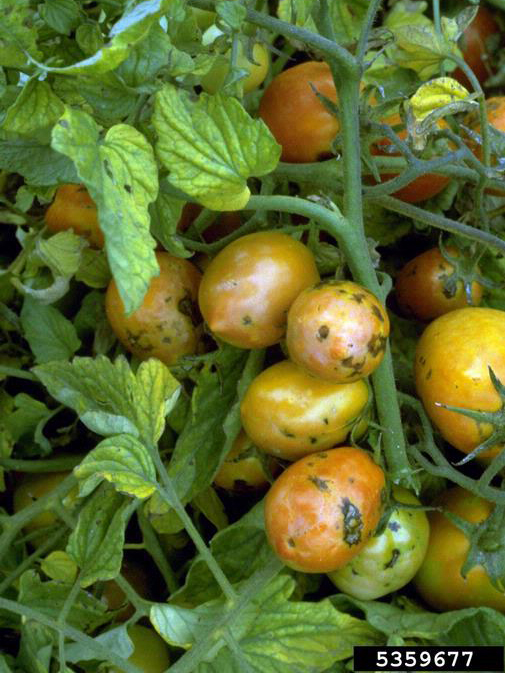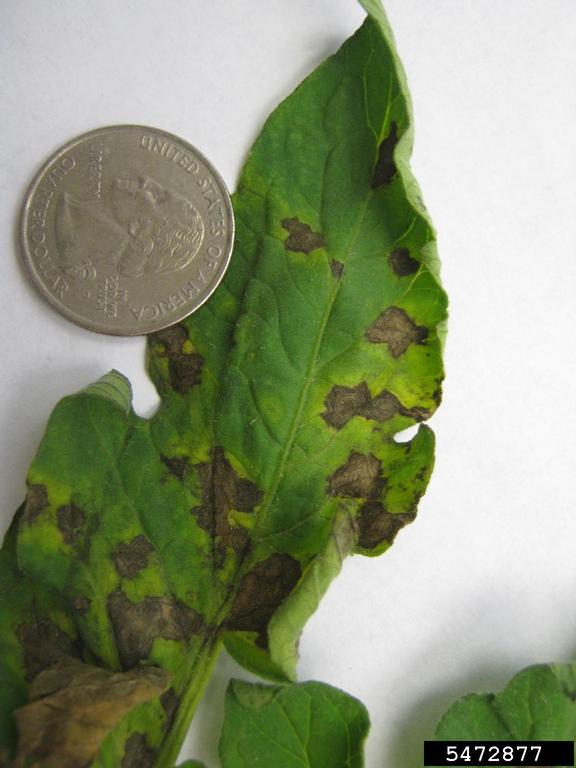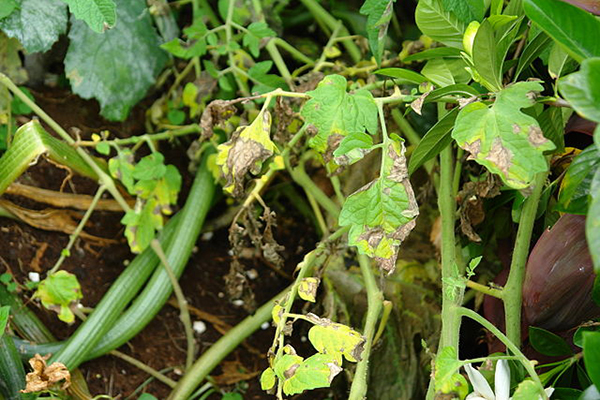Tomato Talk
A Full Season of Tomato-Growing Information
Diseases & Pests, Part 1
Know what pests and diseases look like to troubleshoot before they get in your garden beds. Many stubborn diseases affect tomato plants. Early blight, powdery mildew, bacterial leaf spot, viruses, and soil-borne fungi can quickly put an end to the harvest.

Tomato spotted wilt virus; photo by William M. Brown, Jr., Bugwood.org

Tomato spotted wilt virus; photo by Jason Brock, University of Georgia, Bugwood.org
Know your pests & diseases
Tomato spotted wilt virus is caused by thrips—tiny flying insects that chew tomato flowers and transmit the virus. Young leaves turn bronze with small brown speckles, and the plant is stunted. Tomato guru Craig LeHoullier (author of Epic Tomatoes) suggests using yellow sticky traps around the perimeter of the garden to catch the thrips.
Bacterial spot on tomatoes can be the result of wet conditions in spring, along with temperatures between 75 and 85 degrees Fahrenheit. Affected plants have leaves with small dark spots surrounded by a yellow halo and large numbers of lower leaves dropping.
Leaves that turn yellow could be the result of bacteria or fungus. If the leaves are yellow, but not wilting, and they’re mainly on the lower parts of the plant, remove the leaves and destroy them (don’t place them in the compost pile). If the yellowing quickly spreads upward and the plant is wilting, it’s best to remove and destroy it.
Twisted leaves mottled with light and dark green streaks is often caused by tobacco mosaic virus. The virus is spread by insects, but gardeners can also spread it by touching an infected plant and then touching another plant. The best control and prevention tactics are to plant disease-resistant cultivars and to thoroughly clean up the vegetable garden in the fall.

Late blight of tomato (Lycopersicon esculentum) in a garden near Hilo, Hawaii, caused by Phyophthora infestans; photo by Scot Nelson from Honolulu, Hawaii [CC BY-SA 2.0], via Wikimedia Commons.
Late blight is one of the most devastating tomato diseases. It’s caused when the night temperatures are in the 50s and the days are in the 70s with rain or heavy dew. Infected plants have dark, water-soaked spots on the leaves. The fruits have large, rough brown spots. The plants shed spores that blow onto other tomato plants and infect them as well. If you suspect you have late blight, place the infected plant parts in a plastic zipped bag and bring it to the Garden’s Plant Information Service. The disease does not overwinter in the soil, but infected plants should be removed and destroyed.
Resistance and Tolerance
Some tomato varieties have disease resistance—they can block infection. Others are disease tolerant—they become infected but continue to grow and produce fruit. Learning which varieties are disease resistant and disease tolerant can make for a better harvest next year. Seed catalogs often include letters after a tomato plant’s name to indicate disease resistance. The most common ones are F (fusarium), V (verticillium), LB (late blight), TMV (tobacco mosaic virus), and N (nematodes).
Want to plant disease-resistant varieties? Check out Cornell University's list of disease-resistant vegetable varieties.

